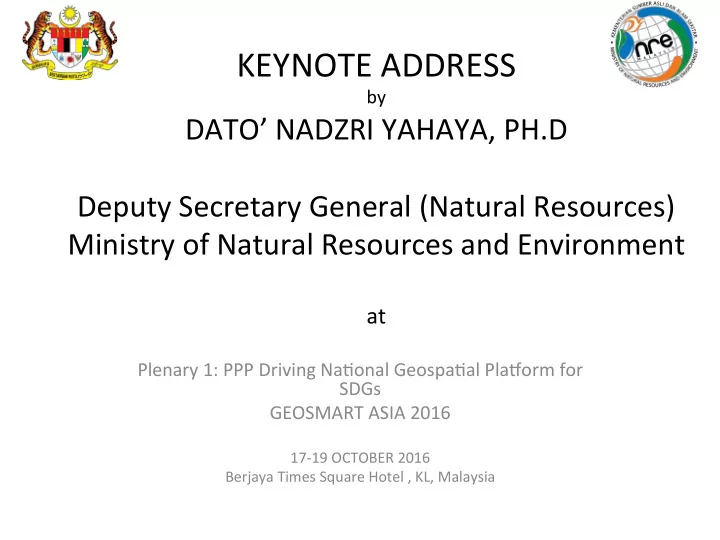

KEYNOTE ADDRESS by DATO’ NADZRI YAHAYA, PH.D Deputy Secretary General (Natural Resources) Ministry of Natural Resources and Environment at Plenary 1: PPP Driving NaLonal GeospaLal PlaMorm for SDGs GEOSMART ASIA 2016 17-19 OCTOBER 2016 Berjaya Times Square Hotel , KL, Malaysia
IMPORTANCE OF GEOSPATIAL INFORMATION We cannot measure and monitor Sustainable Development over Lme in a consistent manner without geography, place and locaLon Consistent and precise posiLoning IS IMPORTANT in predicLng, monitoring and managing global challenges, including those related to climate change, disease pandemics, disaster recovery and food shortages - Report of UN Commi]ee of Experts on Global GeospaLal InformaLon Management (GGIM) - AcLviLes related to Sustainable Development and the post-2015 Development agenda - 2014
2030 AGENDA FOR SUSTAINABLE DEVELOPMENT • 17 Goals, 169 Targets, 230 indicators • Data, especially geospaLal data, is the basis for evidence-based decision-making, monitoring and accountability • clean water and sanitaLon, responsible consumpLon and producLon, climate acLon, life below water and life on land.
VALUE CHAIN OF GEOSPATIAL INDUSTRY • GeospaLal informaLon comprises data relaLng to the physical locaLon and names of objects or businesses. • Geographic InformaLon Systems (GIS) use geospaLal data to examine or demonstrate relaLonships or other characterisLcs. • Services provided can range from basic maps, to sophisLcated provision of geospaLal data and socware for use in the public and private sectors.
VALUE CHAIN OF GEOSPATIAL INDUSTRY • data providers, manufacturers, services companies and distributors of GIS products • The development of geospaLal informaLon has changed substanLally with the advent of digital informaLon and the internet, allowing for rapid development and disseminaLon of GI.
SUSTAINABLE DEVELOPMENT IN MALAYSIA’s CONTEXT : PURSUING GREEN GROWTH UNDER 11 TH MALAYSIA PLAN • Green growth is a game changer because it is not just a stand-alone strategic thrust, but a development trajectory that considers all three pillars of sustainable development • To pursue green growth, the enabling environment will be strengthened — parLcularly in terms of policy and regulatory framework, human capital, green technology investment, and financial instruments. • STRATEGY: CREATE Environmental and geospaLal informaLon management, and indicators
TRANSFORMATION OF GEOSPATIAL DATA IN MALAYSIA( MyGDI) • Establishment of State NaLIS clearinghouse 1997 - 2000 • Digitalizing hardcopy maps • Development of data framewok, standard and policies • Development of Malaysia Geoportal & MyGDI Catalogue, Data eCommerce Driven 2005 • Development of GDC 2010 • Development of Malaysia Geoportal ApplicaWon • Development of metadata catalogue - Driven MyGDI Explorer Service • Development of Driven 1MalaysiaMap • Development of Malaysia geospatial online services – MyGOS (59 2015 agencies)
IMPORTANCE OF SERVICE DELIVERY • The way we do business in the public sector is being challenged today on various fronts, not for providing more and more services, but instead being challenged to making our services delivery as ACCESSIBLE AND PAINLESS as possible to the public. Further, public are also demanding that the services provided is cost-effecLve and its delivery seamless • Tan Sri Mohd Sidek Hj Hassan Former Chief Secretary to the Government
APPLICATIONS OF GEOSPATIAL INFORMATION Business sector: agriculture, transport, • manufacturing, retail and uLliLes; • Government: Very diverse from planning to road maintenance and revenue collecLon to cost saving measures. • Among consumers: GeospaLal informaLon and LocaLon Based Services (LBS) are uLlised in interacLng with educaLon, social networking, hotel, restaurants, tourism, retail and other sectors
GEOSPATIAL INFORMATION UTILIZATION (Services) LAND Management DISASTER Management INFRASTRUCTURE TOURISM HEALTH SECURITY
LAND MANAGEMENT
DISASTER MANAGEMENT
INFRASTRUCTURE PLANNING PUBLIC PUBLIC UTILITY TRANSPORTATION
BENEFIT OF GEOSPATIAL INFORMATION ENVIRONMENT ECONOMIC SOCIAL Banyak peluang perniagaan Menggalakkan Meningkatkan tadbir urus Promote Sustainable Be[er Security dan perkhidmatan pembangunan mampan negara development Disaster Response more Be[er Management and Upgrade infrastructure effecWve and Faster monitoring of natural management system resources Enhance management of Enhance Efficiency in Public coastline, river basin and Enhance Governance and private sector water quality
RECENT DEVELOPMENT • GeospaLal informaLon Industry is set to conLnue expanding with the emergence of new technologies and applicaLons (Unmanned Aerial System-data acquisiLon and mapping) • Increased availability of open/free data will facilitate more innovaLve uses of geospaLal InformaLon (GI). Product differenLaLon on the part of GI • suppliers will be through adding layers of value to free data.
PARTNERSHIP: PUBLIC/PRIVATE • Sharing facility or Equipment • Private Sector provides Services for Government Agency e.g. running programme for Government • Providing Data: Developing Database • Processing InformaLon: conduct Study Together and provide ScienLfic InformaLon
ISSUES AND CHALLENGES • Intellectual Property Right • Privacy and Security adequately addressed • InformaLon COMPLIANCE with acceptable internaLonal standard • Accessibility and delivery of informaLon • Interoperable and should be available and ready for sharing
MOVING FORWARD • Developing Guidelines and Standard OperaLng Procedures (SOP) for the proper and orderly operaLons of UAS for data acquisiLon and mapping. • Developing NaLonal Policy on GeospaLal to facilitate data acquisiLon and informaLon sharing • Master Plan On GeospaLal • LegislaLon Framework: Security, access and informaLon sharing
CONCLUSION • GeospaLal InformaLon is a tool to enhance achievement of SDGs and Targets • Partnership between government and public in data accessibility and sharing as much needed but need to look at security and privacy issues as well as IPR • Policy and legislaLon is required to enhance sharing, easier access and protect security and privacy • Guidelines, SOP and standards for consistent, reliable and Lmely geospaLal InformaLon
THANK YOU
Recommend
More recommend